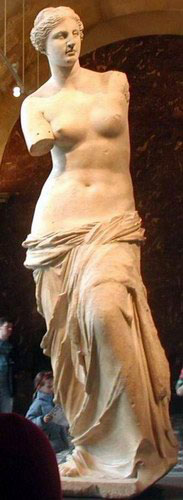Aphrodite of Milos

Aphrodite of Milos is one of the most famous original ancient Greek sculptures in the whole world. It took the name on the island where it was discovered and is currently preserved at the Museum of the Louvre, being one of its most important exhibits. The statue was discovered on 8 April 1820 by a Greek peasant, in a place that was later identified as ancient Milos’ Gymnasium. The French navy officer O. Voutier was there by accident; he realized it was a work of art of great value, thus he contacted the French consul of the island. The news of the discovery reached marquis de Rivière, the French ambassador at Constantinople, who eventually bought the statue, even under the pressure of the French war fleet at Milos. The statue was offered to King Louis XVIII, who immediately donated it to the Louvre.
It is a marble statue 2.11 m high and weighting approximately 900 kg. It portrays a young woman whose torso is nude while her garment covers her hips and legs. She leans on her right leg, while the left is bended towards the front and left. The torso bends and turns, giving the impression of movement, despite the statue’s static character. The face is composed, severe and noble. The identification of the statue with Venus is based on its iconographic similarity with other portraits attributed safely to the goddess; the theory, although by far the most probable, cannot be considered totally sure. The statue was made in the late 2nd century BC, probably by a sculptor from Asia Minor, and is a part of the movement for the revival of the values of Classical art at the end of the Hellenistic era.
A copy of Venus is today placed at the entrance of Milos’ Archaeological Museum, while the place where it was found is marked by a marble inscription.
(Transl. Ioannis Nakas)
Πηγή: www2.egeonet.gr
